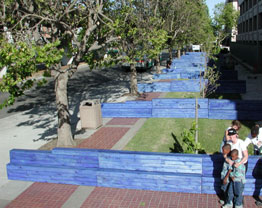|
HOME | SEARCH | ARCHIVE |
|
Landscape in blues
Professor sheds light on neglected West Oakland neighborhood with blues-inspired art installation
![]()
By D. Lyn Hunter, Public Affairs
| |  Overview of the installation "Landscape in Blue", created by landscape architecture chair Walter Hood. |
16 August 2001
|
West Oakland, for many Bay Area residents, is little more than a blur of run-down buildings viewed from a speeding BART train. But Walter Hood, chair of the Landscape Architecture department, sees a thriving neighborhood that is rich in history. And when asked by the San Francisco Museum of Modern Art to participate in its “Revelatory Landscape” show this past spring, Hood chose West Oakland as his canvas, hoping to call attention to what the neighborhood once was, and now is. “The Seventh Street corridor was the center of town for Oakland’s African-American community in the early part of the last century,” said Hood, himself a West Oakland resident. “It was a hub of activity, with blues bars, jazz clubs, shops, and train and ferry terminals.” But starting in the 1960s, more than two-thirds of the district was torn down to make room for highway projects, a BART station and tracks, and a massive postal processing center. These physical transformations changed the fabric of the neighborhood, Hood explained. “The landscape is now dominated by fallow, empty spaces,” he said. “If this kind of work had happened in a downtown area or in the suburbs, you can bet it wouldn’t have been left like this.” These idle tracts of land have been temporarily transformed by Hood and several of his graduate students, with help from artist Doug Hollis. Inspired by the roots music that once floated out of clubs in the area, they created “Landscape in Blue,” an outdoor art project funded by the museum and Berkeley’s Institute for Urban and Regional Development. Through extensive research, the team discovered old plans of the district — including maps used by fire insurance companies — and historical information about the prominent citizens who once inhabited this community. Using this lore, they constructed three components of an art installation. Beneath the BART tracks, 24 individually designed and constructed “blues” benches — with posters on the back “advertising” the area’s legendary music scene, activists and events — mark the site of a former neighborhood church. Near the post office, 12 low wooden walls — representing the 12-bar pattern of blues music — partially outline the foundations where a building once stood. Finally, reflective material applied to the concrete columns that support the BART tracks cast ghostly images of the decaying structures that populate the area. “The designs are meant to expose and interpret what exists rather than obscure what is really there,” said Hood. “We tried to illuminate without being judgmental, melding the past with the present.” Community groups were excited by the installation and its focus on the neighborhood, according to Hood. Several residents stopped by during construction to try out the benches and ask questions. A few were suspicious that the mirrors on the BART columns were some sort of police surveillance system, Hood recalled. The project, on display through Oct. 14, provided a unique opportunity for Hood’s graduate students to learn more about creating public works. “It helps educate students on how to build within a context, within a real-world environment,” he said. Some of the pieces, particularly the benches, have fallen victim to vandalism, an occurrence that doesn’t particularly surprise or bother Hood. “People are shaped by their environment,” he said. “Many residents here have grown accustomed to the bleakness of their landscape, so (they) feel little or no sense of neighborhood pride.” Because of this disenfranchisement, he added, it’s hard to respect objects that others have placed here. “This is a real challenge for designers: to find the linchpin that motivates residents of neglected areas to take ownership of and nurture their environment,” said Hood. “Hopefully, our project will spur the people of West Oakland to consider how they feel about their space.”
Home | Search | Archive | About | Contact | More News
Copyright 2000, The Regents of the University of California.
Produced and maintained by the Office of Public Affairs at UC Berkeley.
Comments? E-mail berkeleyan@pa.urel.berkeley.edu.